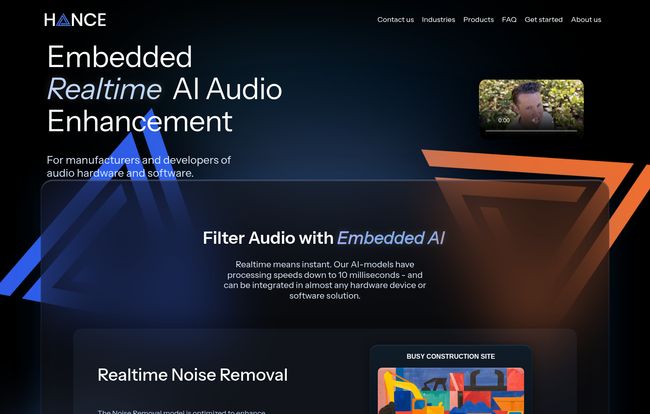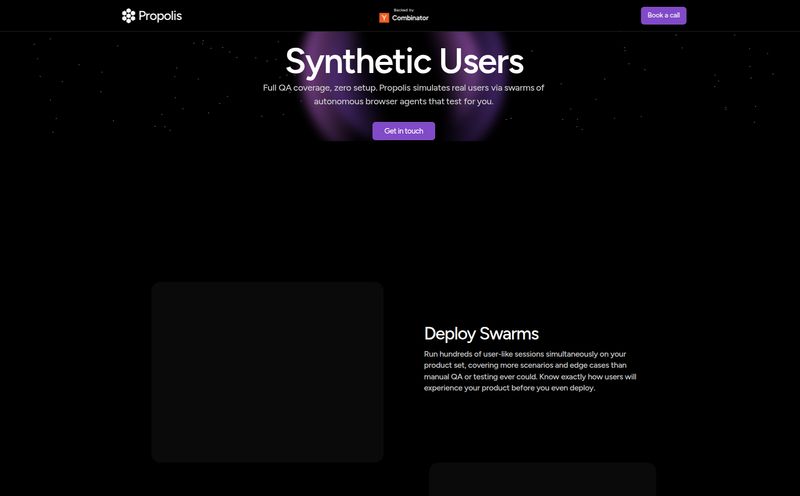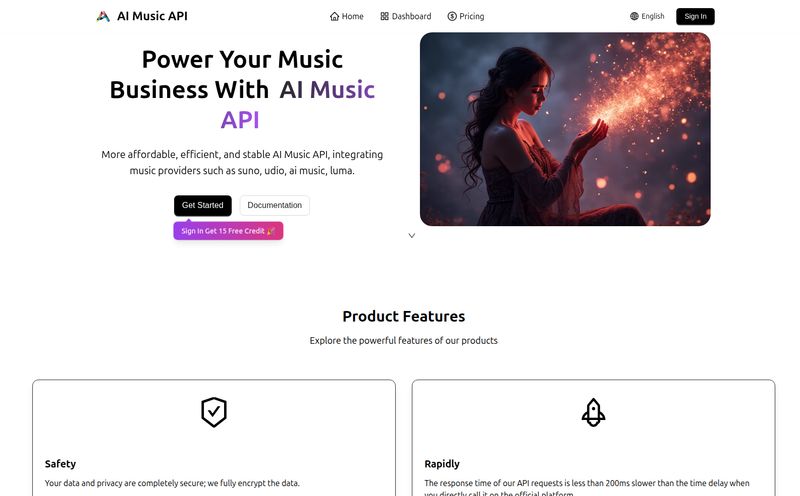You're on the most important client call of the quarter, and your neighbor decides it’s the perfect time to test out their new death metal-inspired leaf blower. Or you’re trying to record a podcast, and the room’s acoustics make you sound like you’re broadcasting from inside a tin can. For years, cleaning up audio has been a tedious, after-the-fact process involving clunky plugins, long rendering times, and a whole lot of prayer.
I’ve spent more hours than I’d like to admit in Adobe Audition, wrestling with noise gates and parametric EQs. It’s a grind. So when I come across a company that claims to do it all in real-time, with a tiny footprint, my ears perk up. Enter Hance.ai.
This isn't just another noise reduction plugin. Hance is playing a different game altogether. They're providing the core machine learning engine for developers and manufacturers to build into their products. Think of it less as a tool you buy and more as a powerful ingredient you add to your own tech recipe. And I have to say, I'm intrigued.
What on Earth is Hance.ai, Really?
Okay, let's cut through the marketing jargon. Hance.ai provides AI algorithms that clean, clarify, and separate audio as it’s happening. The magic word here is “real-time.” We’re talking about a latency as low as 10 milliseconds. That’s faster than you can blink. For reference, anything under about 20ms is generally considered imperceptible for most audio applications.
Instead of a big, heavy program, Hance offers its technology through an API and an SDK (Software Development Kit). This means developers can integrate Hance's brain directly into their own applications, whether that's a video conferencing platform, a live streaming service, or even embedded hardware. It's like having a professional sound engineer living inside your device, but they're impossibly fast and take up almost no space.

Visit Hance.ai
The Core Features That Actually Matter
A lot of tech companies throw a laundry list of features at you. But a few of Hance’s capabilities really stand out to me as potential game-changers.
Real-Time Noise & Echo Removal
This is the bread and butter. Removing background noise (that leaf blower, the chatty office) and reverb/echo (the dreaded bathroom sound) is the holy grail of clear communication. Doing it in real-time without making the voice sound like a robot is incredibly difficult. Hance claims to have cracked it. This has obvious benefits for VoIP, meeting software like Zoom or Teams, and customer support call centers. Better call quality, happier customers, fewer misunderstandings. It’s a clear win.
Real-Time Stem Separation? You're Kidding.
Now this is where it gets really interesting for creatives and specialists. Stem separation is the process of taking a finished piece of audio and splitting it back into its individual parts—vocals, drums, bass, etc. Traditionally, this is an offline, processor-intensive task used by DJs and music producers. The idea of doing it in real-time is… well, it’s wild. Imagine a transcription service that can isolate just the speaker's voice, ignoring all background music and noise, for a perfectly clean transcript. Or a karaoke app that can remove the original vocals from any song on the fly. Teh possibilities are pretty huge.
Lightweight and CPU-Friendly is a Big Deal
In a world of massive AI models that require a server farm and a second mortgage to run, Hance has gone in the opposite direction. Their models are tiny, ranging from just 242KB to 5MB. This is crucial. It means their AI can run efficiently on pretty much any device with a CPU, from a high-end desktop to a smartphone or even a small embedded device in a car. It doesn't drain the battery or turn your laptop into a space heater. This focus on efficiency is, in my opinion, what makes their approach so smart and scalable.
So, Who Is This Actually For?
If you're a podcaster looking for a simple app to clean up your audio, Hance.ai probably isn't for you. Not directly, anyway. Their target audience is clearly B2B: the developers, product managers, and engineers building the next generation of audio-dependent technology.
They’re working with big names like Intel and NVIDIA, which tells you they're serious about performance and integration at the hardware level. They're not building the car; they're building a world-class engine that other car manufacturers can use. So, you might end up using Hance's technology without even knowing it, baked right into the next communication app or smart device you buy.
The Good, The Bad, and The Realistic
No tool is perfect, and from my years in this space, it pays to be a healthy skeptic. The potential here is massive. The ability to basically outsource your audio R&D to a specialized team and integrate their best-in-class tech is a huge value proposition. It saves time, money, and a lot of headaches.
However, let's ground ourselves in reality. One of the cons I've noted is that the demos on their website aren't interactive or real-time. You can hear before-and-after samples, which is great, but you can't upload your own file to test it. This is a bit of a miss for me; in the world of AI, you have to show, not just tell.
Also, integrating an API or SDK is not a simple plug-and-play affair. It requires development resources. This isn't a criticism, just a fact. You'll need a dev team to actually implement this into your product. And while they offer customizable models, that will naturally involve consultation and additional costs. This is standard for enterprise-level solutions.
What About the Hance.ai Pricing?
Ah, the million-dollar question. If you’re looking for a pricing page with neat little tiers, you won't find one. Hance uses a "Book a Meeting" model, which is typical for custom, enterprise-grade B2B solutions.
My take: Don't let the lack of a public price list scare you. It just means they're not selling a one-size-fits-all product. Pricing will likely depend on your specific use case, the volume of usage, the level of customization required, and the support you need. It’s a consultative sale, which for this kind of foundational technology, is exactly what you want.
While I was digging around their site for this review, I even stumbled onto a 404 page. It happens to the best of us! A small reminder that even cutting-edge AI companies have to manage their website, just like the rest of us.
Frequently Asked Questions about Hance.ai
- Is Hance.ai a program I can download and use myself?
- No, not directly. Hance.ai provides its technology as an SDK and API for developers to build into their own applications and products. It's an ingredient, not the final dish.
- What kind of latency can I expect with Hance.ai?
- They advertise latency as low as 10 milliseconds, which is extremely fast and suitable for almost all real-time applications like live calls and streaming.
- How much does Hance.ai cost?
- There is no public pricing. It's an enterprise solution with custom pricing based on your needs. You'll need to book a meeting with their team to get a quote.
- What industries would benefit most from Hance.ai?
- Telecommunications, live streaming platforms, content creation software (DAWs, video editors), automotive infotainment systems, and manufacturers of smart devices would all be prime candidates.
- Does Hance.ai require a powerful GPU to run?
- No, and that's one of its biggest strengths. The models are designed to be lightweight and CPU-efficient, allowing them to run on a wide range of devices without dedicated, high-power GPUs.
- Can I get a custom AI model for my specific audio problem?
- Yes, Hance.ai offers custom AI models. This would require a consultation with their team to define the problem and develop a tailored solution, likely at an additional cost.
Final Thoughts on Hance.ai
Hance.ai is one of those companies that gets me genuinely excited about the future. They aren't just slapping an "AI" label on an old idea. They're tackling a genuinely hard problem—real-time audio processing on-device—with an elegant and efficient solution. For the right company, this technology could be the secret sauce that sets their product apart from the competition.
While it’s not a tool for the average consumer, its impact could be felt by everyone. The next time you have a crystal-clear video call from a noisy café or listen to a perfectly balanced live stream, there’s a chance a little bit of Hance magic is running in the background. And that's a future that sounds pretty good to me.
Reference and Sources
- Hance.ai Official Website
- Intel for Developers - To understand the context of their partnerships.
- Sound on Sound: Latency Explained - A great technical read on why low latency in audio matters.



